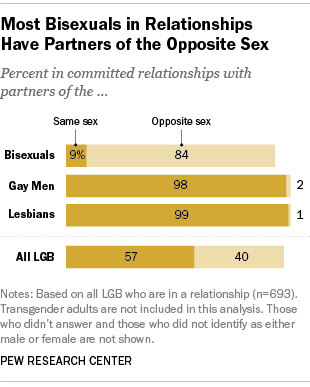Over the past few years, much of the energy aimed at securing rights and benefits for LGBT adults has focused on same-sex marriage. But often absent from discussions about same-sex marriage and LGBT issues more broadly are the views and experiences of bisexual adults – the “B” in LGBT.
While some high-profile music artists and actors have talked about their bisexuality, openly bisexual adults are becoming increasingly more visible in other aspects of public life. This week, Kate Brown became the first openly bisexual governor in the U.S. when she was sworn in to her new role in Oregon. Brown follows in the footsteps of Rep. Kyrsten Sinema of Arizona, who became the first openly bisexual member of Congress when she took office in 2013.
 Compared with gay men and lesbians, bisexuals have a different perspective on their sexual orientation and a distinct set of experiences, according to a 2013 Pew Research Center survey of nearly 1,200 lesbian, gay, bisexual and transgender adults. Bisexuals are much less likely than gay men and lesbians to say that their sexual orientation is an important part of who they are. Only 20% of bisexuals say being bisexual is extremely or very important to their overall identity. The shares of gay men (48%) and lesbians (50%) who say the same about their sexual orientations are much higher. (Due to the small number of transgender adults in the survey, it’s not possible to break out their responses. However, they are included in the total LGBT shares reported here.)
Compared with gay men and lesbians, bisexuals have a different perspective on their sexual orientation and a distinct set of experiences, according to a 2013 Pew Research Center survey of nearly 1,200 lesbian, gay, bisexual and transgender adults. Bisexuals are much less likely than gay men and lesbians to say that their sexual orientation is an important part of who they are. Only 20% of bisexuals say being bisexual is extremely or very important to their overall identity. The shares of gay men (48%) and lesbians (50%) who say the same about their sexual orientations are much higher. (Due to the small number of transgender adults in the survey, it’s not possible to break out their responses. However, they are included in the total LGBT shares reported here.)
Bisexuals are also much less likely than gay men or lesbians to have “come out” to the important people in their life. Only 28% of bisexuals say all or most of the important people in their life know they are bisexual. By comparison, 77% of gay men and 71% of lesbians say the important people in their life know about their sexual orientation.
Relatively few bisexuals report that they have experienced discrimination because of their sexual orientation. When we asked about six specific types of incidents – ranging from being subjected to slurs and jokes (the most common experience among all LGBT respondents) to being treated unfairly by an employer (the least common), bisexuals were significantly less likely than gay men or lesbians to have experienced most of them.
There’s also a sense among all LGBT adults that society is more accepting of bisexual women than it is of gay men, lesbians or bisexual men. A third of LGBT adults say there is a lot of acceptance for bisexual women. Fewer (25%) say there’s a lot of acceptance for lesbian women, and fewer still see a lot of acceptance for gay men (15%) and bisexual men (8%). Transgender adults are viewed as being the least accepted by society (3% say there’s lot of acceptance for this group).
One way in which bisexuals are similar to gay men and lesbians is in their own journey to self-awareness about their sexual orientation. The survey asked LGBT respondents at what point in their life they had first thought they might be lesbian, gay, bisexual or transgender; at what age they knew for sure; and at what age they first told someone about their sexual orientation. Bisexuals experienced these milestones at nearly the same ages as lesbians and gay men. The median age when bisexuals report first thinking that they might be bisexual is 13. The median age at which they say they knew for sure that they were bisexual is 17, and they were a median age of 20 when they first told someone about their sexual orientation.
It’s difficult to determine the size and composition of the LGBT population, especially using a survey-based approach that relies on the willingness of individuals to disclose their sexual orientation and gender identity. Some researchers have estimated that between 3.5% and 5% of the U.S. population identifies as lesbian, gay, bisexual or transgender.
 In our 2013 LGBT survey, which included a nationally representative sample of 1,197 self-identified LGBT adults, 479 (or 40%) of the respondents were bisexual. And among the bisexuals who were surveyed, a large majority (73%) were women; only 27% were men.
In our 2013 LGBT survey, which included a nationally representative sample of 1,197 self-identified LGBT adults, 479 (or 40%) of the respondents were bisexual. And among the bisexuals who were surveyed, a large majority (73%) were women; only 27% were men.
Bisexuals are much more likely than gay men or lesbians to be married, and most have a spouse of the opposite sex. Roughly a third (32%) of the bisexual women in our survey were married, as were 23% of bisexual men. By comparison, only 4% of gay men and 6% of lesbians were legally married.
Looking more broadly at LGBT adults who are in committed relationships (whether married or not), almost all gay men (98%) and lesbians (99%) are in relationships with same-sex partners. Only 9% of bisexuals have same-sex partners; fully 84% are involved with someone of the opposite sex.



